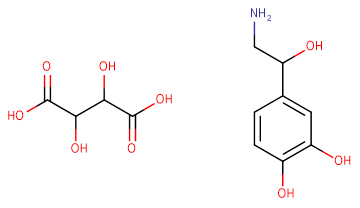
Noradrenaline bitartrate
CAS No. 69815-49-2
Noradrenaline bitartrate( —— )
Catalog No. M15678 CAS No. 69815-49-2
orepinephrine is the principal transmitter of most postganglionic sympathetic fibers and of the diffuse projection system in the brain arising from the locus ceruleus.
Purity : >98% (HPLC)
 COA
COA
 Datasheet
Datasheet
 HNMR
HNMR
 HPLC
HPLC
 MSDS
MSDS
 Handing Instructions
Handing Instructions
| Size | Price / USD | Stock | Quantity |
| 50MG | 34 | In Stock |


|
| 100MG | 45 | In Stock |


|
| 200MG | 64 | In Stock |


|
| 500MG | Get Quote | In Stock |


|
| 1G | Get Quote | In Stock |


|
Biological Information
-
Product NameNoradrenaline bitartrate
-
NoteResearch use only, not for human use.
-
Brief Descriptionorepinephrine is the principal transmitter of most postganglionic sympathetic fibers and of the diffuse projection system in the brain arising from the locus ceruleus.
-
Descriptionorepinephrine is the principal transmitter of most postganglionic sympathetic fibers and of the diffuse projection system in the brain arising from the locus ceruleus. It is also found in plants and is used pharmacologically as a sympathomimetic.
-
In Vitro——
-
In Vivo——
-
Synonyms——
-
PathwayAngiogenesis
-
TargetAdrenergic Receptor
-
RecptorAdrenergic Receptor
-
Research Area——
-
Indication——
Chemical Information
-
CAS Number69815-49-2
-
Formula Weight319.26
-
Molecular FormulaC8H11NO3
-
Purity>98% (HPLC)
-
SolubilitySoluble in Water
-
SMILESOC(C(O)C(O)=O)C(O)=O.NCC(O)C1=CC(O)=C(O)C=C1
-
Chemical Name——
Shipping & Storage Information
-
Storage(-20℃)
-
ShippingWith Ice Pack
-
Stability≥ 2 years
Reference
1.Lachnit WG, et al. Br J Pharmacol. 1997 Mar;120(5):819-26.
molnova catalog



related products
-
JNJ-63533054
JNJ-63533054 is a potent and selective agonist of hGPR139 with an EC50 = 16 nM.
-
Tizanidine
Tizanidine is an α2-adrenergic receptor agonist and inhibits neurotransmitter release from CNS noradrenergic neurons.
-
Practolol
Practolol is a selective β-adrenoceptor blocker.



 Cart
Cart
 sales@molnova.com
sales@molnova.com


